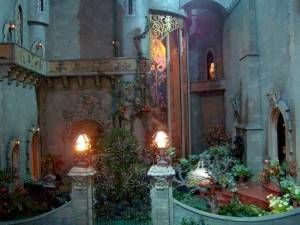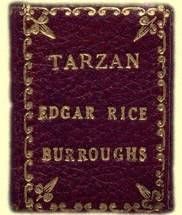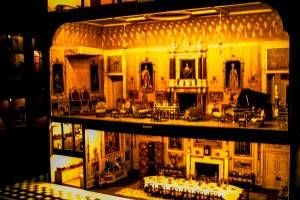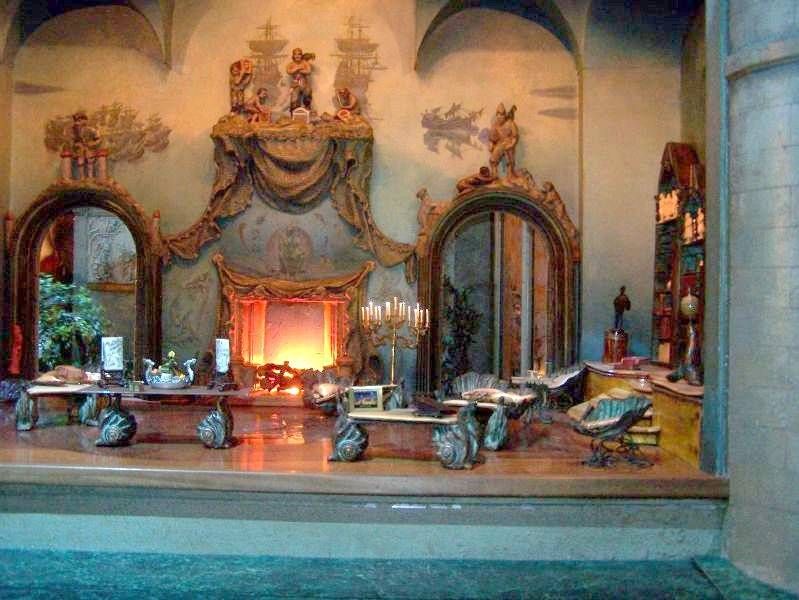
Miniature Libraries
Earlier this month, Derek wrote about The Smallest Book in the World (and Other Really Little Books). Everyone loves the charm of miniature books, but a few collectors have taken this love above and beyond to create some of the most unique and valuable libraries in the world.
That’s right, I’m talking about doll house libraries. In the 1920s, two women created doll houses so fantastic they’ve both been described as invaluable. But among the many tiny treasures in each house, the library collections are the most unique.
Colleen Moore’s Fairy Castle
A silent film star, Moore started building her fairy castle in the late ’20s with the help of an actual architect and contractor. It has running faucets, electricity, and themed rooms for all of Moore’s favorite fairy tale characters. The star of the Fairy Castle, though—at least as far as we’re concerned—is the library, which contains over 150 miniature books, including original works by writers such as George Bernard Shaw and Edgar Rice Burroughs, written in the authors’ own hand.
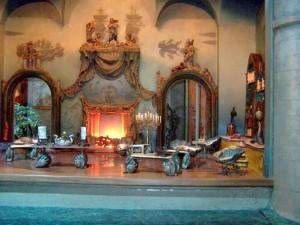
The library in Moore’s Fairy Castle.
Image by kthypryn
Originally the library consisted entirely of antique books dating from the 18th- and 19th-centuries, including the world’s smallest printed Bible, a gift from one of Moore’s costars. But Moore sought to expand her collection, and had numerous 1-inch bound books made up, which she then sent to famous writers in the hopes they would contribute some of their own work. The list of writers who accepted Moore’s challenge is a who’s-who of early 20th century literature: Agatha Christie, F. Scott Fitzgerald, Aldous Huxley, Sinclair Lewis, Willa Cather, Daphne du Maurier, Edgar A. Guest, and John Steinbeck, just to name a few. Some, like Fitzgerald, transcribed a few lines from their previously published work; others, like Edna Ferber, wrote a simple thank you along with their signature. But a few authors wrote whole, original stories, like Shaw’s wildly spelled story (he would get a kick out of LOLcats, I’m thinking) about a fairy prince and “prissess,” and her struggle to afford a new lace gown. Pretty heavy stuff for a 1-inch book! Edgar Rice Burroughs wrote “Tarzan, Jr.,” a multi-chapter story illustrated by John Coleman Burroughs about a little Princess who disobeys her mama and goes into the forbidden forest.
These images of “Tarzan, Jr.” are used with permission from ERBzine:

©ERB, Inc.
Tarzan is a registered TM of ERB, Inc.
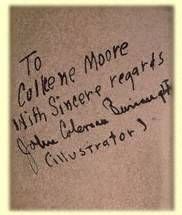
©ERB, Inc.
Tarzan is a registered TM of ERB, Inc.
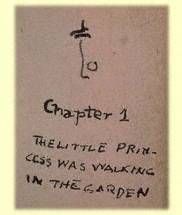
©ERB, Inc.
Tarzan is a registered TM of ERB, Inc.
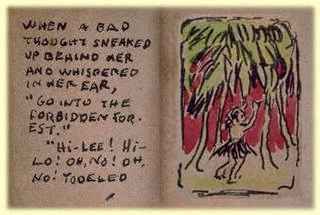
©ERB, Inc.
Tarzan is a registered TM of ERB, Inc.
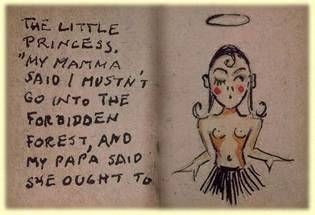
©ERB, Inc.
Tarzan is a registered TM of ERB, Inc.
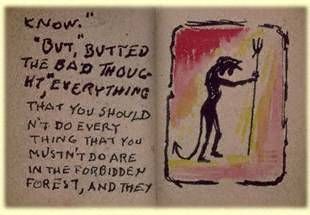
©ERB, Inc.
Tarzan is a registered TM of ERB, Inc.
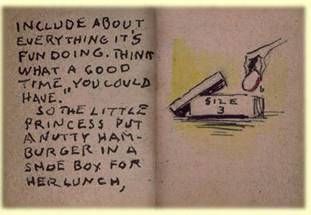
©ERB, Inc.
Tarzan is a registered TM of ERB, Inc.
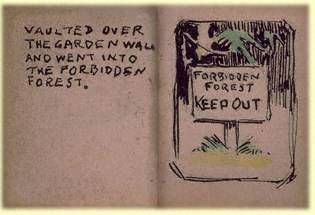
©ERB, Inc.
Tarzan is a registered TM of ERB, Inc.
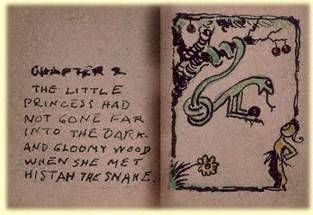
©ERB, Inc.
Tarzan is a registered TM of ERB, Inc.
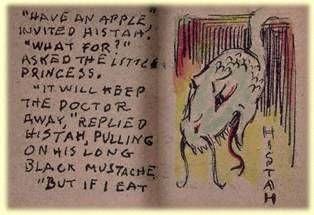
©ERB, Inc.
Tarzan is a registered TM of ERB, Inc.
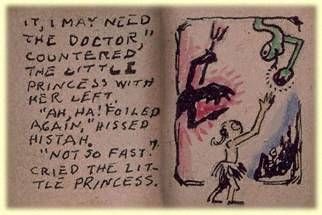
©ERB, Inc.
Tarzan is a registered TM of ERB, Inc.
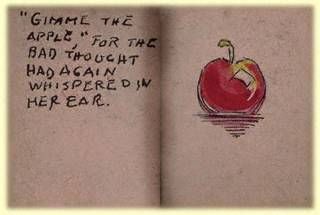
©ERB, Inc.
Tarzan is a registered TM of ERB, Inc.
Queen Mary’s Dolls’ House
Even more impressive is the library in Queen Mary’s Dolls’ House, which Stephen Gaselee called, “a miniature picture of English literature in the nineteen-twenties.” Unlike Moore’s Fairy Castle, Queen Mary’s Dolls’ House was created with a nationalistic sensibility. Started in 1921 and finished in 1924, what originally started as plaything for the Queen to display her collection of miniatures became a symbol of Britain’s recovery from World War I. Over 1500 people were employed in its creation, including 600 writers, from all corners of the British Empire.
The Queen’s Dolls’ House was actually the brainchild of Princess Marie Louise of Schleswig-Holstein, King George V’s cousin and a childhood friend of Queen Mary, and it was she who became the Doll’s House unofficial librarian, sending out hundreds of personal requests to authors to contribute to the project as well as creating the library’s catalog. The list of authors whose work is housed in Queen Mary’s Dolls’ House library is truly dizzying. Unlike Moore’s library, the vast majority of books contributed are original works written specifically for the House, including “How Watson Learned the Trick” by Sir Arthur Conan Doyle, “Meditations of a Refugee” by Max Beerbohm, “A Tragedy in Outline” by Anthony Hope, and “The Haunted Dolls’ House” by MR James. Two of my favorite olde-timey writers, GK Chesterton and Edith Wharton, both contributed poems; and John Buchan, William J Locke, Edmund Blunden, Siegfried Sassoon, and Sir Philip Gibbs all wrote pieces about WWI.
It wasn’t just fiction that earned a place in the Dolls’ House: famed surgeon Sir John Bland-Sutton wrote “Principles of Dolls’ Surgery” (rather gruesome); the woman who oversaw the creation of the House’s garden, horticulturalist Gertrude Jekyll, wrote “The Book of the Garden,” which is placed in the garden (so meta, you guys); and her sister, Agnes Jekyll, the very first food columnist for The Times, oversaw the stocking of the House’s kitchen and wrote “The Dolls’ House Cookery Book,” which advises brioche with hot chocolate and whipped cream for breakfast, and Chelsea buns with Russian ice made of blackcurrant leaves for tea parties. I don’t what either of those things are, but they sound delicious. And in every book in the House is an itty-bitty bookplate designed by Ernest Shepard and inscribed MR (for Mary Regina) Ex Libris.
These doll house libraries are fascinating not just because of the books they contain, but because of the leap of imagination and curiosity both books and doll houses require. You can’t enter a doll’s house, but you can picture yourself inside, or perhaps envision miniature residents who have stepped out for a few hours and might return any minute. Likewise, books can take you to other places or give you a peek at others’ lives. Unfortunately, that potential is lost on both of these libraries, as the vast majority of their books have never even been opened, let alone read.
There is, however, one book that’s an exception–the Queen Mary’s Dolls’ House library’s most famous volume, a book of verses by “Fougasse,” the celebrated cartoonist who was an editor at Punch Magazine. It has been printed in life-size under the title J. Smith and you can not only read it, but own it for your personal library.
Further Reading:
- The Queen’s Dolls’ House by Lucinda Lambton (Royal Collection, 2010)
- Within the Fairy Castle (Museum of Science and Industry, 2010)
- ERBzine: Tarzan, Jr.
- Daily Mail: Tiny Children’s Book Hand Drawn for Queen Mary’s Doll’s House to be Published in Human Size
_________________________
Sign up for our newsletter to have the best of Book Riot delivered straight to your inbox every two weeks. No spam. We promise.
To keep up with Book Riot on a daily basis, follow us on Twitter, like us on Facebook, , and subscribe to the Book Riot podcast in iTunes or via RSS. So much bookish goodness–all day, every day.



